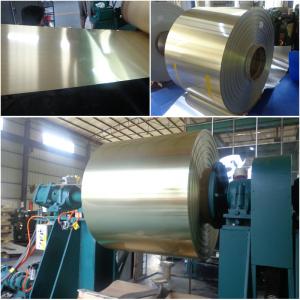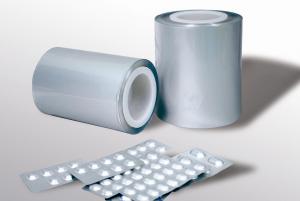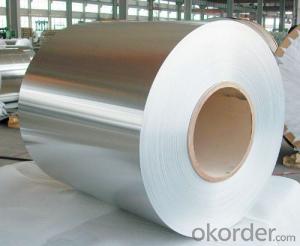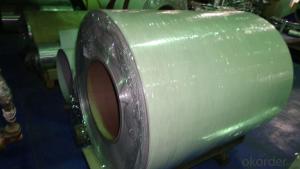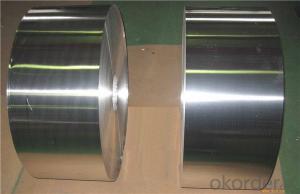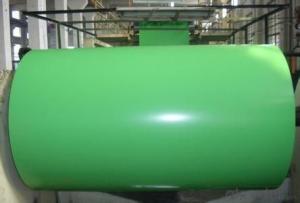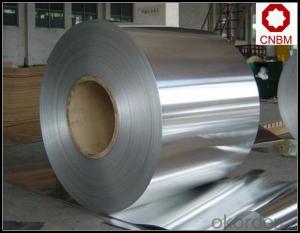Aluminum Can end stock and Can tab stock
- Loading Port:
- China Main Port
- Payment Terms:
- TT OR LC
- Min Order Qty:
- -
- Supply Capability:
- -
OKorder Service Pledge
OKorder Financial Service
You Might Also Like
Cans cover (ring)pre-coated plates
First, the raw materials
Aluminum lid and pull the main substrate of aluminum from the southwest andNanshan Aluminum, the use of aluminum-magnesium alloy 5182H19, 5052H19. Itsproducts in the normal substrates of manganese and magnesium components addedto increase the tensile strength and elongation. Han and the lotion by theGerman food-grade chrome HD agent, the United States PPG epoxy phenolicpackaging coatings, and high-end DOS oil
Second,applications
Division I professional production of DOS card and aluminum cans with a coatingfor cans of the lid and pull the coated aluminum is widely used in beverage,beer, rice pudding, tea, cigarettes, cans and other products packaging. U.S.imports of food ash using electrostatic spray wax, cut by large waves, transverseshear, longitudinal easily processed into the system covered the pre-coatedaluminum manufacturers. Depending on the system covers equipment can makeweight and volume of different specifications to meet customer requirements.
Third, the application prospect
Cans of food packaging as lightweight, unbreakable, easy to carry transportcharacteristics, cans packaged foods will gradually replace the glass packagingfood. As
Alloy & specification
Alloya | Coated panel,strip status | Status | Aluminum thicknessa t/mm | Aluminum Specificationa /mm | Aluminum coil specificationa /mm | ||
Width | length | width | Steeve Φ | ||||
5052、5182 | H46、H48、H49 | H18、H19、 H36、H38、H39 | 0.22≤t≤0.50 | 500~1600 | 500~4000 | 20~1600 | 300、350、 405、505 |
a.Other alloy, specification of material can be negotiated | |||||||
Aluminum thickness
Aluminum thickness | Thickness tolerance(±) |
>0.22~0.30 | 0.005 |
>0.30~0.50 | 0.008 |
Width and Length
Alloy | Aluminum panel&coil length tolerance/mm | Aluminum Panel & coil width tolerance/mm /mm | ||||
Pop top | Pop can cover | |||||
Length≤2000 | Length >2000 | width≤100 | width >100 | width≤1000 | width >1000 | |
5052 5182 | +1 0 | +2 0 | ±0.2
| +1.5 0 | +1.0 0 | +1.5 0 |
Dynamic features
Alloy | Status | thickness(t)/mm | Room temperature tensile test results | ||
Tensile strength Rm/MPa | non-proportional extension strengthRp0.2/MPa | elongationA50mm /% | |||
≥ | |||||
5052 | H36 | >0.22~0.30 | 255~305 | 200 | 2 |
>0.30~0.50 | 255~305 | 200 | 3 | ||
H18、H38 | >0.22~0.30 | 270 | 210 | 2 | |
>0.30~0.50 | 270 | 210 | 3 | ||
H19、H39 | >0.22~0.30 | 290 | 220 | 2 | |
>0.30~0.50 | 290 | 220 | 3 | ||
5182 | H36 | >0.22~0.30 | 265~340 | 270 | 3 |
>0.30~0.50 | 265~340 | 270 | 4 | ||
H18、H38 | >0.22~0.30 | 330 | 285 | 3 | |
>0.30~0.50 | 330 | 285 | 4 | ||
H19、H39 | >0.22~0.30 | 340 | 295 | 3 | |
>0.30~0.50 | 340 | 295 | 4 | ||
Coating function
Suppliershould ensure DOS oil of pop can cover is up to 5~10mg/m2/side, and coating surface should bewith even wax which is up to 40~100mg/m3/side
Food and packing industry pop can covercoating aluminum panels’ features:
Function | Coating weightg/m2 | Deviation of coating | T Bend | MEK | High temperature sterilization | S Resist-ance | Acid resista-nce | Adhe -sion | |
Pop can Cover | Outer coating | 3~6 | ≤10 | ≤2 | >50 | See Note.1 | - | - | 1 Grade |
Inner coating | 10~13 | ≤10 | ≤2 | - | See Note.1 | See Note.2 | See Note3 | 1 Grade | |
Pop can tab | 2 sides coating | 3~6 | ≤10 | ≤2 | >50 | See Note.1 | - | - | 1 Grade |
Note: 1 After121℃,30min distill,Internal and external coating without white, loss of light, peeling, and shedding. 2 After121℃,30min S corrosion,Internal and external coating without white, loss of light, peeling, and shedding. 3 After121℃,30min acid erosion,Internal and external coating without white, loss of light, peeling, and shedding. | |||||||||
The surface of the pop cans cover coatingdoes not allow defects such as air bubbles, scratches, missing coating,over-burning, oil spots, stains, streaks, color, piebald, roller printing,embossing, periodic prints, chemical liquid etc which impact users.
Each coil allowed a joint which does notallow loose layer or dislocation, the joint can only be overlapped, which needto make the mark in the end, and each batch coil of joint is not morethan 10% of the total number of coils.
Services
Supporting services: Offering semi-finishedproducts & OEM services
- Q:What are the different coil widths available for aluminum coils?
- The coil widths available for aluminum coils can vary depending on the specific requirements and manufacturing capabilities. However, common standard coil widths for aluminum coils typically range from 12 inches (304.8 mm) to 60 inches (1524 mm). These standard widths are commonly used in various industries, including construction, automotive, and packaging. In addition to the standard widths, manufacturers can also provide custom coil widths to meet specific customer needs. These custom widths can be narrower or wider than the standard range, allowing for more flexibility in design and application. It is important to note that the availability of specific coil widths may vary depending on the supplier and the specific aluminum alloy being used. Therefore, it is recommended to consult with a reputable aluminum coil supplier to determine the exact range of coil widths available for a particular project or application.
- Q:If this is true then how do I take my aluminums temperature without fear of breaking the themometer and get mercury all over it?
- Yes, okorder /... But I would not be afraid of taking the temperature of Aluminum...just be careful not to break the thermometer and it will be fine. Now-a-days, most common thermometers don't use Mercury anymore....it has been replaced with a colored alcohol which allows for colder temperatures to be measured as well as eliminates the possibility of a toxic substance being released upon breakage.
- Q:What are the different types of aluminum coils available?
- There are several different types of aluminum coils available in the market. Each type is designed to cater to specific requirements and applications. 1. Mill Finish Aluminum Coils: These coils have a plain, shiny surface with no additional treatments or finishes applied. They are often used in general applications where aesthetics are not a major concern. 2. Anodized Aluminum Coils: Anodizing is an electrochemical process that forms a protective layer on the surface of the aluminum. This type of coil is highly corrosion-resistant and provides excellent durability. Anodized aluminum coils are commonly used in architectural applications, such as building facades, window frames, and signage. 3. Painted Aluminum Coils: These coils are coated with a layer of paint, typically through a coil coating process. The paint provides not only aesthetic appeal but also protection against weathering, UV radiation, and corrosion. Painted aluminum coils are widely used in the construction industry, for roofing, cladding, and rainwater goods. 4. Embossed Aluminum Coils: These coils have a textured or patterned surface created by embossing rollers. The embossed patterns can vary from simple designs to intricate motifs, providing both aesthetic appeal and enhanced slip resistance. Embossed aluminum coils are commonly used in flooring, decorative panels, and transportation applications. 5. Pre-painted Aluminum Coils: Similar to painted coils, pre-painted aluminum coils are coated with paint. However, the coating is applied before the coil is formed, allowing for greater flexibility in terms of color options and finishes. Pre-painted aluminum coils find applications in various industries, including automotive, appliance manufacturing, and signage. 6. Clad Aluminum Coils: Clad aluminum coils consist of two layers of aluminum bonded together, usually through a rolling or extrusion process. The purpose of the clad is to combine the desirable properties of different aluminum alloys, such as strength, corrosion resistance, or conductivity. Clad aluminum coils are commonly used in the automotive, aerospace, and electrical industries. In addition to these types, there are also specialized aluminum coils available for specific applications, such as heat exchangers, condenser coils, and transformer windings. These coils are designed with specific properties and characteristics to meet the requirements of these specialized applications.
- Q:I recently had to have a course of B-12 injections (my digestive system was not properly absorbing other forms). While I felt a significant improvement in mood, energy and memory, I was very concerned to discover that the B-12 shot came with a little something extra: aluminum! I'm wondering if the benefits outweigh the potential risks - why is aluminum placed in the injection? (Are there metal free versions out there?)
- Dietary okorder
- Q:How are aluminum coils used in the production of automotive parts?
- The production of automotive parts heavily relies on aluminum coils, which possess essential properties such as lightweightness and resistance to corrosion. As a result, these coils find extensive usage in the manufacturing of different automotive components. A significant application of aluminum coils in the automotive industry involves their incorporation into body panels. These coils undergo processing to transform them into sheets, which are then molded and shaped into body panels like hoods, doors, fenders, and roofs. The utilization of aluminum's lightweight nature aids in reducing the overall weight of the vehicle, leading to enhanced fuel efficiency and improved handling. Additionally, aluminum coils contribute to the production of heat exchangers utilized in automotive air conditioning systems and radiators. The remarkable thermal conductivity of aluminum facilitates efficient heat transfer, ensuring optimal cooling performance. This feature is crucial in maintaining the desired temperature within the vehicle's interior and preventing engine overheating. Furthermore, aluminum coils play a vital role in the manufacturing of various engine components. They are extensively employed in the production of cylinder heads, engine blocks, and intake manifolds. Aluminum's high strength-to-weight ratio makes it an ideal material for these applications, as it provides strength and durability while simultaneously reducing the engine's overall weight. Moreover, aluminum coils find utility in the production of suspension components, including control arms and subframes. The lightweight nature of aluminum enables enhanced suspension performance, resulting in improved handling and a more comfortable ride. To summarize, the utilization of aluminum coils in the production of automotive parts is widespread due to their lightweight, corrosion-resistant, and high-strength properties. These coils are employed in the manufacturing of body panels, heat exchangers, engine components, and suspension parts, all of which contribute to the overall performance, efficiency, and durability of vehicles.
- Q:What are the common surface cleaning methods for aluminum coils?
- There exist various effective surface cleaning techniques for aluminum coils, which can eradicate dirt, debris, and other impurities. Among the most frequently employed methods is pressure washing. This involves utilizing a high-pressure water spray to dislodge and eliminate any dirt or grime from the coil's surface. Pressure washing can be conducted using specialized equipment or simply a regular garden hose with a spray nozzle attachment. Chemical cleaning serves as another popular approach for cleansing aluminum coils. This method entails utilizing specific cleaning agents or solvents, specially formulated to break down and eradicate dirt and impurities from the coils' surface. These chemicals are typically applied using a spray bottle or a pump sprayer and then rinsed off with water after a designated period. Steam cleaning represents another effective technique for cleaning aluminum coils. This involves employing high-temperature steam to loosen and eliminate dirt and grime from the coil's surface. Steam cleaning is often used in conjunction with a cleaning agent or solvent to enhance its efficacy. In addition to these methods, there are specialized tools available, such as coil cleaning brushes or fin combs, which can be utilized to physically remove any debris or build-up from the coil surfaces. These tools prove particularly useful for eliminating smaller particles or debris that may be trapped in between the fins of the coils. It is essential to note that when cleaning aluminum coils, it is crucial to adhere to the manufacturer's recommendations and guidelines to ensure the cleaning process is conducted safely and effectively. Additionally, regular cleaning and maintenance of aluminum coils can promote their longevity and preserve their efficiency.
- Q:Can aluminum coils be used in aerospace applications?
- Indeed, aerospace applications do make use of aluminum coils. The aerospace industry extensively utilizes aluminum due to its lightweight nature and impressive strength-to-weight ratio. Aircraft structures, including fuselages, wings, and landing gear, often incorporate aluminum coils. Moreover, heat transfer and cooling systems also benefit from their presence. The exceptional corrosion resistance and high thermal conductivity of aluminum coils render them fitting for diverse aerospace purposes. Furthermore, their malleability and ease of fabrication enable the creation of intricate shapes and designs necessary for aerospace components.
- Q:Can aluminum coils be used for decorative purposes?
- Yes, aluminum coils can be used for decorative purposes. They are commonly used in various decorative applications such as trim work, wall panels, ceilings, and decorative accents. Aluminum coils offer versatility in terms of color, texture, and finish, allowing for creative and aesthetically pleasing designs.
- Q:a) Although Aluminium is a reactive metal, it is used to make door frames and window frames.b) Although Aluminium conducts heat, it is used to make blankets, which are good thermal insulators.
- a) Aluminium forms oxide on its surface thus protecting it. This protective oxides help the inner part being corroded / reacted . Its highly maliable and dectile property is also good. Thats why !!!!!!!! b) For making thermal insulators, i think, thin layers (maliability) of aluminium is using, where in between the layers the trapped air which is a poor thermal conductors, which gives the property.
- Q:How do you clean and maintain aluminum coils?
- Achieving clean and well-maintained aluminum coils can be accomplished by following a few straightforward steps. Initially, gather the necessary materials such as a soft brush or vacuum cleaner, a mild detergent or coil cleaner, a water hose, and a spray bottle. Commence by deactivating the power supply to the unit and ensuring that it is safe to proceed. Subsequently, employ a soft brush or a vacuum cleaner with a brush attachment to eliminate any debris or loose dirt from the coils. It is crucial to exercise gentleness to prevent harm to the delicate fins of the coils. Upon removal of loose dirt, combine a solution of mild detergent or coil cleaner with water within a spray bottle. Thoroughly spray the solution onto the coils, making certain that it covers the entire surface. Allow the solution to sit for a few minutes to enable it to penetrate the dirt and grime. Once the solution has had sufficient time to work, delicately scrub the coils using a soft brush or a soft cloth. Caution must be exercised to avoid applying excessive pressure or utilizing abrasive materials, as this could result in damage. Particular attention should be given to areas with obstinate dirt or buildup. Following a thorough cleaning of the coils, rinse them off with a water hose. It is crucial to ensure that all the detergent or coil cleaner is completely washed away. It is recommended to direct the water flow in the opposite direction of the air flow in order to prevent the pushing of debris further into the coils. Subsequent to rinsing, allow the coils to completely dry before reactivating the power supply. This will prevent potential electrical hazards. The utilization of a fan or the natural air drying process can be employed. To uphold the cleanliness of the coils, it is advisable to clean them at least once a year or more frequently if the unit is exposed to heavy dirt or debris. Regular inspection of the coils for dirt buildup and prompt cleaning will aid in maintaining efficiency and prolonging the lifespan of the aluminum coils.
1. Manufacturer Overview |
|
|---|---|
| Location | |
| Year Established | |
| Annual Output Value | |
| Main Markets | |
| Company Certifications | |
2. Manufacturer Certificates |
|
|---|---|
| a) Certification Name | |
| Range | |
| Reference | |
| Validity Period | |
3. Manufacturer Capability |
|
|---|---|
| a)Trade Capacity | |
| Nearest Port | |
| Export Percentage | |
| No.of Employees in Trade Department | |
| Language Spoken: | |
| b)Factory Information | |
| Factory Size: | |
| No. of Production Lines | |
| Contract Manufacturing | |
| Product Price Range | |
Send your message to us
Aluminum Can end stock and Can tab stock
- Loading Port:
- China Main Port
- Payment Terms:
- TT OR LC
- Min Order Qty:
- -
- Supply Capability:
- -
OKorder Service Pledge
OKorder Financial Service
Similar products
New products
Hot products
Hot Searches
Related keywords
